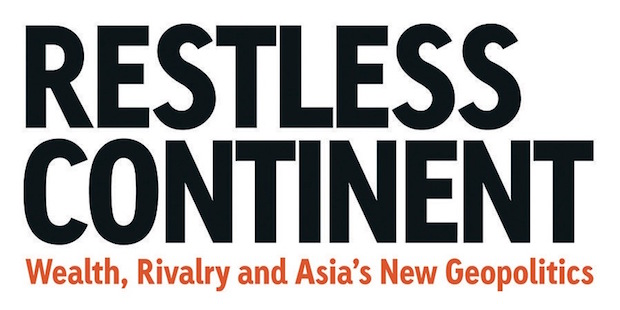Restless Continent: Wealth, Rivalry and Asia's New Geopolitics

Speeches on foreign affairs often begin with the claim that we are living in a period of unprecedented change. Equally often, they invoke the Chinese curse, ‘May you live in interesting times’. Change in human affairs, of course, is constant and while turbulent times are interesting for some, they are frightening for others. When Australian leaders advocate stability in our region, they obviously hope to perpetuate the benefits of the present arrangements and fear the consequences of them being changed.
To call Asia a ‘restless continent’, as Professor Michael Wesley does in his new book, appears to state the obvious and at the same time, to warn the unwary. His collated extracts from the histories of several Asian countries demonstrate that stability has never prevailed and is not likely to. Great civilisations in Asia have risen, fallen and revived and the process continues. What interests him now is the impact of new and reinvented trade routes, efforts to redraw national and maritime borders and rivalries within and between nations. His very wide focus is on the geo-politics of an Asia he loosely defines as extending from the Middle East to Japan, a region whose growing economic and military power, he says, will give it global dominance in this, the Asian Century.
The freedom with which human activities, interactions and consumption can occur anywhere in the world is what Wesley calls ‘globalism’: the end-product, presumably, of the much-discussed process of ‘globalisation.’ But globalism, he warns, is not the end of history, even though the global institutions devised since 1945 by the West to maintain its power remain in place. Rather, it is globalism and those institutions, whose demise he predicts.
Moving thematically back and forth across Asian history and geography, Wesley advocates seeing the world from the standpoint of the people in Asian countries, as many Asian Studies scholars at ANU have done before him. Competition and inherited grudges between these societies, he shows, go back many centuries and traditional sensitivities about status remain strong. But now, high-achieving countries with growing populations and rising aspirations increasingly challenge the international order by creating new institutions to meet their needs and by demanding appropriate respect for their views.
Wesley anticipates interesting times. He foresees a period of ‘disarticulation’ in which several great powers will compete to establish middle-kingdom-style zones of influence, each requiring deference and resources from lesser neighbours in their fiefdoms. The nations in control of these zones – which he says are already under construction by China and Russia – will negotiate with each other about how to run the world. Even trade, the Internet and cyberspace, he predicts, will be controlled within each zone by this ‘new feudalism’. With international competition stalled, the prospects include slower economic growth, more poverty and even more damage to the environment.
Australia gets only one line in the rather selective index to Wesley’s book, perhaps because we are not a significant competitor in Asia, or because we are not Asian. Remember 1993, when Samuel Huntington added Australia to his ‘clash of civilisations’ thesis only as an afterthought, calling it a ‘torn country’, neither Western nor Asian. By concentrating on Asia and barely mentioning Australia, Wesley similarly sidesteps this perennial issue and does not explicitly advocate that in the disarticulated geopolitics of the future, Australia should meekly accept China as its feudal overlord. To do that, he would have to admit that the ANZUS alliance is or will be redundant and that Australia will have no choice. Instead, he opts for an academic position on the fence, on the one hand calling Australia’s 2012 Asian Century White Paper ‘Panglossian’ in its optimism and on the other, describing predictions by an American scholar about the geopolitics of strategic Asia (Aaron L Friedburg in Ashley J Tellis and others, 2010) as pessimistically ‘Hobbesian’. In fact, the same fence separates the positions taken in the Asian Century White Paper and those still being tackled in Australia’s long-delayed Defence White Paper.
American statesmen often call the United States a ‘Pacific country’. America’s influence in Asia is another question which this book leaves unanswered. Wesley admits that US hegemony is in decline and assumes that a process of disarticulation will take place without resulting in World War III. But he does not discuss whether America will peacefully accept other powers claiming rival spheres of influence or will resist them with devastating force. Nor does he explain how future feudal overlords will meet the demands of rising middle classes solely from the resources within their own fiefdoms, without raiding the others, potentially resulting in a war of all against all. Moreover, if the feudal powers, as he predicts, are unconstrained by global opinion about environmental conservation, they will surely destroy the resources of their fiefdoms even faster than is happening now, soon causing massive movements of people to find higher ground, clean air, water and food and thus making regional boundaries meaningless.
Wesley’s disarticulation theory depends on the coexistence of equal or near equal fiefdoms. Yet he begins and ends with the assumption – already familiar from Kishore Mahbubani, Stephen FitzGerald and others – that Asia will be ‘the major shaper of the world for the foreseeable future.’ As such, Asia is already more equal than other contenders. If China is to be Asia’s feudal overlord and Asia shapes the world, then it follows that China is effectively the new global or feudal hegemon. For the West to resist this prospect, all Wesley can propose is more ‘robust globalism’, in which the preferences of non-Western countries are better represented and carry more weight. To ask how that is to come about seems too problematic or perhaps too practical a question to find space in his book.
Conflict between Muslims in what Wesley defines as Asia and the aggressive claims of the world’s Muslims for respect and influence in the West, are other significant issues, which he leaves unexplored. They cannot be ignored. Islamic chauvinism appears to erode any prospect of a huge Asian fiefdom dominated by China, including the Middle East. When Huntington in the 1990s predicted a world divided into eight civilisations, that was much derided for being geopolitically indeterminate. But he foresaw Islamic extremism as the greatest contender with the US for global dominance and what he wrote bears re-reading today.
Michael Wesley, Restless Continent, Black Inc. Publishing, 2015.
Dr Alison Broinowski is a Research Affiliate at ANU.





